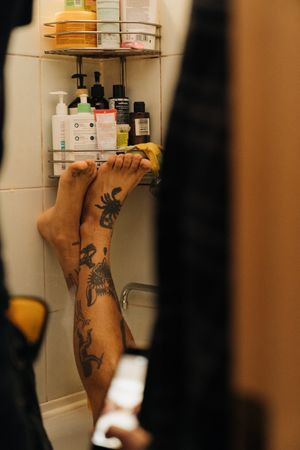So, you’ve got some fresh ink and you’re eager to keep it clean, but you’re wondering, How Long Can You Shower After A Tattoo? At tattooat.com, we understand the importance of proper tattoo aftercare to preserve the vibrancy and longevity of your body art. You can shower soon after getting a tattoo, but with precautions to avoid infection and ink fading by washing it properly, so you can confidently maintain your new masterpiece. Keep reading to discover the best practices for showering after a tattoo, ensuring a smooth and vibrant healing process.
1. Can I Shower After Getting a Tattoo?
Yes, you can shower after getting a tattoo, but timing and method are key. You can take a short, lukewarm shower a few hours after getting a tattoo. Avoid direct water pressure on the new tattoo and ensure you use mild, fragrance-free soap.
Showering is an essential part of tattoo aftercare, helping to remove bacteria and prevent infection. However, it’s crucial to do it right to protect the integrity of your new ink. According to the American Academy of Dermatology, gentle washing with mild soap is recommended to keep the area clean and promote healing. The key is to balance hygiene with the need to protect the delicate, healing skin.
1.1. Immediate Aftercare:
- Saniderm Bandage: If your tattoo artist used a Saniderm bandage, this waterproof covering allows you to shower almost immediately. Saniderm protects the tattoo from water and bacteria, but it’s still wise to avoid direct, high-pressure water.
- Plastic Wrap: If your tattoo is covered with plastic wrap, wait at least 24 hours before showering. Plastic wrap doesn’t breathe and can trap moisture, creating a breeding ground for bacteria.
1.2. How to Prepare for Your First Shower:
- Gather Your Supplies: Before you step into the shower, make sure you have everything you need:
- Mild, fragrance-free, antibacterial soap
- Clean, soft towel
- Keep it Short and Sweet: Long, hot showers can damage your new tattoo. Aim for a quick rinse to minimize exposure to water and heat.
- Lukewarm Water is Key: Hot water can open your pores and cause the tattoo ink to leach out. Stick to lukewarm water to protect your ink.
2. How to Shower Safely After Getting a Tattoo
Showering safely after a tattoo involves a few simple steps to minimize risk. The method you use is crucial to prevent infection, irritation, and fading. With a bit of care, you can keep your new ink looking its best while staying clean.
Here’s how to shower safely with a new tattoo:
2.1. Saniderm Protection
If your tattoo artist used Saniderm, you’re in luck. This medical-grade, waterproof bandage provides a protective barrier against water and bacteria.
2.2. Gentle Washing Technique
If you don’t have Saniderm, you’ll need to take extra precautions:
- Avoid Direct Water Flow: Don’t let the shower stream directly hit your new tattoo. Instead, use your hand to gently splash water over the area.
- Use Mild Soap: Fragrance-free, antibacterial soaps are best. Harsh soaps can irritate the skin and cause the ink to fade.
- Wash Gently: Use your fingertips to gently clean the tattoo. Avoid scrubbing or using a washcloth, as this can damage the healing skin.
2.3. Pat Dry, Don’t Rub
Once you’re out of the shower, pat your tattoo dry with a clean, soft towel. Rubbing can irritate the skin and cause damage. Ensure the area is completely dry before applying any aftercare products.
 Woman gently patting a new tattoo dry with a soft towel, emphasizing careful aftercare
Woman gently patting a new tattoo dry with a soft towel, emphasizing careful aftercare
2.4. Proper Aftercare Application
After drying, apply a thin layer of tattoo aftercare ointment. According to a study by Portland State University’s Art Department, in July 2023, proper hydration with a moisturizing ointment can significantly reduce healing time and improve ink retention.
3. What to Avoid When Showering with a New Tattoo
Knowing what to avoid is just as important as knowing what to do. Certain practices can hinder the healing process and increase the risk of infection. Here’s a list of things to avoid when showering with a new tattoo:
3.1. Hot Water
As mentioned earlier, hot water can open your pores and cause ink to leach out. Stick to lukewarm water to protect your tattoo.
3.2. Prolonged Exposure
Keep your showers short to minimize exposure to water. Prolonged soaking can lead to skin maceration and increase the risk of infection.
3.3. Harsh Soaps and Scrubs
Avoid using harsh soaps, exfoliants, or scrubs on your new tattoo. These can irritate the skin and damage the ink.
3.4. Soaking in the Bath
Submerging your tattoo in a bath can introduce bacteria and prolong the healing process. Avoid baths until your tattoo is fully healed.
 Image showing a person in a bathtub with a tattoo out of the water, representing the need to avoid soaking the tattoo
Image showing a person in a bathtub with a tattoo out of the water, representing the need to avoid soaking the tattoo
4. How Long After a Tattoo Can You Shower Normally?
After about 2 to 4 weeks, once your tattoo is fully healed, you can shower normally. The exact timeframe depends on your body’s healing rate and the size and location of the tattoo.
4.1. Signs of Healing
Before you resume your normal shower routine, make sure your tattoo is fully healed. Signs of a healed tattoo include:
- No redness or swelling
- No scabbing or flaking
- Skin feels smooth to the touch
4.2. Gradual Reintroduction
Even when your tattoo is mostly healed, it’s a good idea to gradually reintroduce your normal shower routine. Start by using lukewarm water and mild soap, and slowly increase the temperature and pressure as your skin tolerates it.
4.3. Continued Moisturizing
Even after your tattoo is fully healed, continue to moisturize it regularly to keep the skin healthy and the ink vibrant.
5. Can You Shower an Hour After Getting a Tattoo?
Showering an hour after getting a tattoo is generally not recommended. It’s best to wait at least a few hours, or even a full day, to allow the initial healing process to begin.
5.1. Why Waiting is Important
- Ink Setting: The ink needs time to settle into the skin. Showering too soon can disrupt this process and cause fading.
- Open Wound: A new tattoo is essentially an open wound. Exposing it to water and soap too soon can increase the risk of infection.
5.2. Exceptions
If your tattoo artist used Saniderm, you can shower sooner. Saniderm provides a waterproof barrier that protects the tattoo from water and bacteria. However, it’s still a good idea to wait a few hours to allow the initial healing process to begin.
 Image depicting someone checking a tattoo covered with a bandage shortly after getting it, emphasizing early aftercare
Image depicting someone checking a tattoo covered with a bandage shortly after getting it, emphasizing early aftercare
5.3. What to Do Instead
If you need to clean the area within the first few hours, use a clean, damp cloth to gently wipe away any excess ink or blood. Avoid using soap or submerging the tattoo in water.
6. Can You Shower With Saniderm On A Tattoo?
Yes, you can shower with Saniderm on a tattoo. Saniderm is a breathable, waterproof bandage that protects the tattoo from water and bacteria. It’s designed to stay on for several days, allowing you to shower without worrying about infection or damage.
6.1. How to Shower With Saniderm
- Ensure a Good Seal: Make sure the Saniderm is properly sealed around the tattoo. If there are any gaps or openings, water can get in and cause problems.
- Avoid Direct Pressure: While Saniderm is waterproof, it’s still a good idea to avoid direct water pressure on the tattoo.
- Pat Dry: After showering, gently pat the Saniderm dry with a clean towel.
6.2. When to Remove Saniderm
Your tattoo artist will advise you on when to remove the Saniderm. Generally, it can stay on for 3-5 days. When removing it, do so gently and slowly, peeling it back in the direction of hair growth.
6.3. What to Do After Removal
After removing the Saniderm, wash the tattoo with mild soap and water, and apply a thin layer of aftercare ointment. Continue to moisturize the tattoo regularly until it is fully healed.
7. How Long After a Tattoo Can You Take a Bath?
You should avoid taking a bath for at least 3-4 weeks after getting a new tattoo. Submerging your tattoo in water for an extended period can increase the risk of infection and damage the ink.
7.1. Risks of Bathing Too Soon
- Bacterial Exposure: Bathwater can harbor bacteria that can cause infection in your new tattoo.
- Ink Leaching: Soaking in water can cause the ink to leach out, leading to fading and blurring.
- Prolonged Moisture: Extended exposure to moisture can soften the skin and make it more susceptible to damage.
7.2. Alternatives to Bathing
If you need to clean yourself, opt for quick showers instead of baths. Keep the tattoo out of the direct water flow and use mild soap.
7.3. When It’s Safe to Bathe
Once your tattoo is fully healed, you can resume taking baths. However, it’s still a good idea to avoid prolonged soaking and to use mild, fragrance-free products.
 Image showing a sign indicating no swimming after tattoos, highlighting the importance of avoiding water submersion
Image showing a sign indicating no swimming after tattoos, highlighting the importance of avoiding water submersion
8. How Long After a Tattoo Can You Swim?
Swimming should be avoided for at least 3-4 weeks after getting a tattoo. Chlorine in pools and salt water in the ocean can both be harmful to healing tattoos.
8.1. Dangers of Swimming Too Soon
- Chlorine Irritation: Chlorine can irritate the skin and cause the ink to fade.
- Salt Water Dehydration: Salt water can dehydrate the skin, slowing down the healing process.
- Bacterial Contamination: Public pools and oceans can harbor bacteria that can cause infection.
8.2. Protective Measures
If you must swim, use a waterproof bandage like Saniderm to protect the tattoo. However, this is not a foolproof solution, and it’s still best to avoid swimming altogether.
8.3. Post-Swim Care
If you do swim, rinse the tattoo immediately with clean water and apply a thin layer of aftercare ointment. Monitor the area for any signs of infection, such as redness, swelling, or pus.
9. Will Soaking A New Tattoo Fade It?
Yes, soaking a new tattoo can cause it to fade. Prolonged exposure to water can leach the ink from the skin, resulting in a duller, less vibrant tattoo.
9.1. Preventing Fading
To prevent fading, avoid soaking your tattoo in baths, pools, or hot tubs. Keep showers short and avoid direct water pressure on the tattoo.
9.2. Proper Aftercare
Proper aftercare is essential for preventing fading. This includes:
- Keeping the tattoo clean
- Moisturizing regularly
- Protecting the tattoo from the sun
9.3. Long-Term Care
Even after your tattoo is fully healed, continue to protect it from the sun and moisturize it regularly to keep the ink vibrant for years to come.
10. How Long After a Tattoo Can You Wash It With Soap?
You can gently wash your new tattoo with hypoallergenic soap 24 hours after getting it. While you can rinse your new tattoo within 3-4 hours, it’s best to wait 24 hours to gently wash it with hypoallergenic soap. Always follow the instructions of your tattoo artist for when to apply soap.
10.1. Choosing the Right Soap
Opt for a mild, fragrance-free, antibacterial soap. Avoid soaps with harsh chemicals or alcohol, as these can dry out the skin and damage the ink.
10.2. Washing Technique
- Use lukewarm water
- Gently lather the soap with your fingertips
- Avoid scrubbing or using a washcloth
10.3. Drying and Moisturizing
After washing, pat the tattoo dry with a clean, soft towel and apply a thin layer of aftercare ointment.
FAQ: Showering After a Tattoo
1. Can I use regular soap on my new tattoo?
No, use mild, fragrance-free, antibacterial soap to avoid irritation.
2. What if my tattoo gets wet accidentally?
Pat it dry immediately with a clean towel and apply aftercare ointment.
3. How often should I shower with a new tattoo?
Once a day is usually sufficient, unless you get dirty or sweaty.
4. Can I use a loofah to wash my tattoo?
No, loofahs can be too abrasive and may harbor bacteria.
5. What if my Saniderm bandage starts to peel off?
Consult your tattoo artist. They may advise you to remove it or apply a new bandage.
6. Is it normal for ink to come out when I shower?
Yes, some ink loss is normal during the initial healing phase.
7. Can I use a hair dryer to dry my tattoo?
No, the heat can damage the skin. Always pat it dry with a soft towel.
8. What if I see signs of infection?
Consult a doctor or tattoo artist immediately.
9. Can I exercise after getting a tattoo?
Avoid excessive sweating and friction. Keep the tattoo clean and dry.
10. How long does it take for a tattoo to fully heal?
It typically takes 2-4 weeks, but it can vary depending on the individual and the size and location of the tattoo.
Conclusion
Taking care of a new tattoo requires patience and attention to detail. By following these guidelines on showering after a tattoo, you can ensure a smooth and vibrant healing process. Remember, proper hygiene and aftercare are essential for preserving the beauty and longevity of your body art.
At tattooat.com, we’re dedicated to providing you with the best information and resources for all your tattoo needs. From finding the perfect design to connecting with talented artists, we’re here to help you every step of the way.
Ready to explore stunning tattoo designs, find skilled artists, and dive deeper into the world of tattoo knowledge? Visit tattooat.com today and let us help you on your tattoo journey.
Address: 1825 SW Broadway, Portland, OR 97201, United States
Phone: +1 (503) 725-3000
Website: tattooat.com
